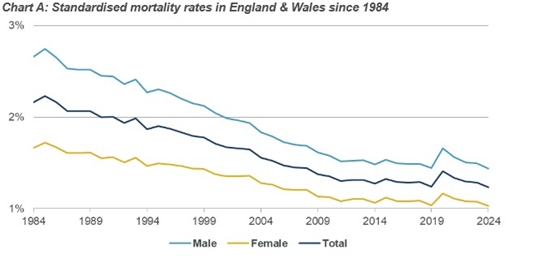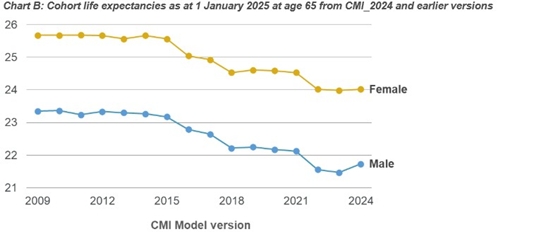CMI_2024 produces cohort life expectancies at age 65 that are about three months higher for males and about two weeks higher for females than in the previous version of the CMI model, CMI_2023.
The CMI has made significant changes to the method for CMI_2024, now that the short- to medium-term impact of the pandemic on mortality is better understood. This follows consultation with users, who were largely supportive of the proposals.
Versions of the CMI Model from CMI_2020 to CMI_2023 addressed the impact of the pandemic by placing no weight on data for 2020 or 2021 and reduced weight on data for 2022 and 2023. In contrast, CMI_2024 puts full weight on data for every year and introduces a new “overlay” term to explicitly model the initial increase in mortality caused by the pandemic as well as the fall in the following years.
Standardised mortality rates in England & Wales have fallen each year since 2020. All-age mortality in 2024 was the lowest on record, but still higher than what the CMI Model projected before the pandemic. Mortality to date in 2025 has also been relatively low, and comparable to the corresponding period in 2024.
Mortality trends have varied significantly by age. Although mortality in 2024 reached record lows at pensioner ages, mortality for younger working ages remained above the 2014-2023 average. CMI_2024 reflects this by allowing trends to differ by age more than in previous versions, and this drives the increase in life expectancies at pensioner ages, particularly for males.
Cobus Daneel, Chair, CMI Mortality Projections Committee, said: “We were pleased that responses to the consultation on CMI_2024 showed broad support for our proposal. The key changes made allow better modelling of mortality as we emerge from the pandemic and should provide a sound foundation for future years. While recent mortality has been close to record lows, the outlook for mortality remains uncertain. We encourage users of our model to consider adjusting the model’s parameters to reflect their own portfolios and views on the impact of the pandemic.”
Detailed results
Chart A shows standardised mortality rates (which allow for consistent comparisons of mortality over time) in the general population of England & Wales from 1984 to 2024.
There was a pronounced steady fall in mortality until 2011, but falls were more modest from 2011 to 2019. The increase in mortality from 2019 to 2020 was exceptional, with mortality in 2020 returning to levels previously seen in 2008. Mortality fell between 2020 and 2024, returning to levels similar to the previous record low mortality observed in 2019.

Chart B shows the progression of cohort life expectancy at age 65 in successive versions of the CMI Model. The figures for CMI_2024 are around 20 months lower than in the first version, CMI_2009.

For more information on the CMI Mortality Projections Model, CMI_2024, please see the FAQs.
The CMI Mortality Projections Committee produces “mortality monitors” – with monthly summaries of emerging mortality and more detailed analyses quarterly.
|

